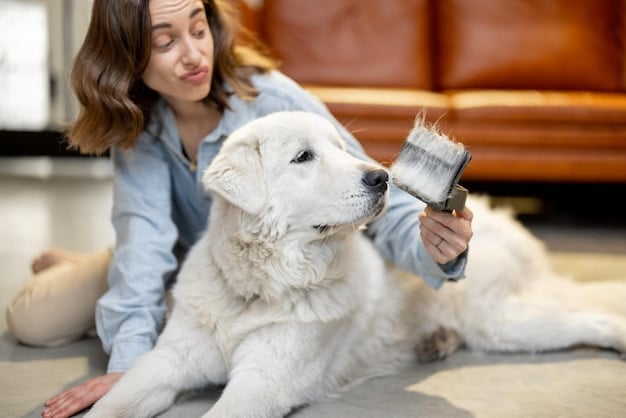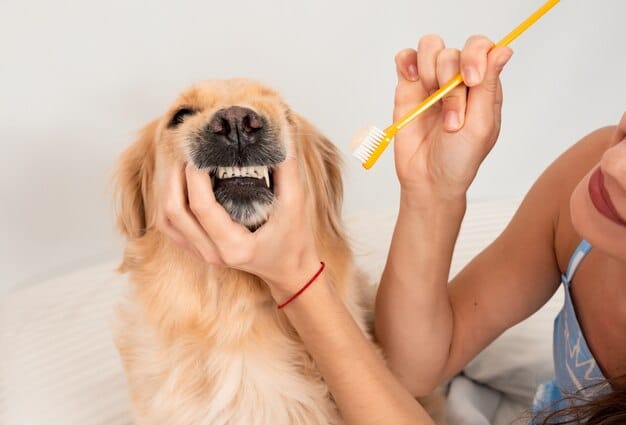DIY Pet Care: Save $50+ on Grooming & Supplies Monthly

Achieving significant monthly savings on pet care, specifically DIY pet care: save $50+ monthly on grooming and supplies with these simple hacks, involves adopting practical at-home grooming techniques, optimizing food and treat purchases, and crafting homemade toys and accessories, all contributing to substantial financial benefits for pet owners.
In today’s economic climate, every dollar counts, and for pet owners, the costs associated with animal companionship can add up quickly. If you’re looking to implement DIY pet care: save $50+ monthly on grooming and supplies with these simple hacks, you’ve come to the right place. This guide will help you embark on a journey towards more economical pet ownership without compromising on the well-being and happiness of your beloved furry friends.
Mastering at-home grooming: baths, brushes, and nail trims
One of the most significant recurring expenses for pet owners is professional grooming. While groomers offer convenience and expertise, many essential grooming tasks can be safely and effectively performed at home, leading to substantial savings. Understanding the basics of at-home grooming not only reduces costs but also strengthens the bond between you and your pet, fostering a sense of trust and comfort.
Bathing your pet at home is a relatively straightforward task, provided you have the right supplies and a patient approach. Choosing a quiet time when your pet is relaxed is crucial. Always use pet-specific shampoos and conditioners, as human products can irritate their skin. A slip-resistant mat in the tub or shower can make the experience safer and more comfortable for both of you. Remember to thoroughly rinse all shampoo to prevent skin residue that could cause irritation.
Effective bathing techniques
- Preparation is key: Before getting your pet wet, brush out any loose fur and tangles. This prevents matting, which can be painful and difficult to remove once wet.
- Protect their ears: Place cotton balls gently into your pet’s ears to prevent water from entering, which can lead to ear infections.
- Use lukewarm water: Ensure the water temperature is comfortable. Too hot or too cold can stress your pet.
- Lather gently: Work the shampoo into their coat, starting from the neck and working your way down, avoiding direct contact with their eyes and nose.
Regular brushing is another cornerstone of at-home grooming. Depending on your pet’s coat type, daily or weekly brushing can prevent matting, reduce shedding, and distribute natural oils, promoting a healthy, shiny coat. For short-haired breeds, a rubber curry brush works well to remove loose hair. Long-haired pets often benefit from a slicker brush or a de-shedding tool. Consistent brushing also allows you to check for any skin issues, parasites, or unusual lumps that might require veterinary attention.
Nail trims are often intimidating for pet owners, but with proper technique and patience, they are entirely manageable. Untrimmed nails can cause discomfort, lead to paw problems, and even affect your pet’s gait over time. Investing in a good quality pair of pet nail clippers specific to your pet’s size is a good first step. There are various types, including scissor-style and guillotine-style clippers. If you’re unsure, consulting with your veterinarian or watching reliable online tutorials can provide valuable guidance.
Safe nail trimming tips
- Identify the quick: The quick is a blood vessel and nerve ending within the nail. Cutting into it is painful and can cause bleeding. For light-colored nails, it’s visible as a pinkish area. For dark nails, it’s harder to see, so trim small amounts at a time.
- Have styptic powder ready: In case of an accidental quick cut, styptic powder can quickly stop the bleeding.
- Positive reinforcement: Reward your pet with treats and praise during and after the trim to create a positive association with the process.
By integrating these at-home grooming practices into your routine, you can significantly reduce trips to the professional groomer, saving a considerable amount monthly. Furthermore, these routine interactions build trust and comfort between you and your pet, making future grooming sessions even easier and more enjoyable for both of you.
Smart sourcing: DIY pet food, treats, and sustainable feeding
Beyond grooming, pet food and treats represent a substantial portion of monthly pet expenses. While commercial pet foods are convenient, exploring DIY options for preparing meals and treats, combined with strategic purchasing, can lead to remarkable savings. This approach also gives you greater control over the ingredients your pet consumes, ensuring a healthier diet free from undesirable additives.

When considering homemade pet food, it’s crucial to consult with a veterinarian or a veterinary nutritionist. They can help you create a balanced diet that meets all of your pet’s nutritional needs based on their age, breed, and health status. A common mistake is to feed pets a diet that lacks essential vitamins and minerals, which can lead to long-term health issues. However, if properly formulated, homemade meals can be highly beneficial.
For many pet owners, homemade treats are a safer and easier entry point into DIY pet nutrition. Simple ingredients like peanut butter (xylitol-free), pumpkin, oats, sweet potatoes, and lean meats can be combined to create delicious and healthy treats. Baking treats in bulk and storing them in an airtight container or freezing them can save time and money compared to buying small packages of commercial treats regularly. There are countless recipes available online for dog biscuits, catnip toys, and even frozen puzzles.
Economical pet food strategies
- Bulk buying: Purchase pet food in larger quantities from warehouses or wholesale clubs. Often, the larger the bag, the lower the price per pound. This requires adequate storage space and ensuring the food remains fresh.
- Loyalty programs and sales: Sign up for loyalty programs at your local pet stores or online retailers. Many offer discounts, special promotions, or points that accumulate for future purchases. Keep an eye out for sales events, especially around holidays.
- Compare brands, compare prices: Don’t be afraid to switch brands if you find a high-quality, more affordable alternative that your pet enjoys. Read reviews and compare ingredient lists to ensure you’re still providing optimal nutrition.
Sustainable feeding also encompasses waste reduction. Storing food properly in airtight containers prevents spoilage, which means less food (and money) goes to waste. Portion control is another important aspect; overfeeding costs more and can lead to pet obesity, which brings its own set of health problems and veterinary bills. Utilizing slow feeders or puzzle feeders can extend mealtime, promoting better digestion and mental stimulation, while also reducing the amount of food consumed per sitting, thereby making your bulk purchases last longer.
By incorporating these intelligent sourcing and DIY food strategies, you can significantly trim your monthly pet care budget. Not only do you save money, but you also gain a deeper understanding of your pet’s nutritional requirements and can offer them fresher, often healthier, food options. This proactive approach to pet nutrition is a win-win for both your wallet and your pet’s health.
Crafting entertainment: homemade toys and enrichment activities
Pets, especially puppies and kittens, often require a constant supply of toys to keep them entertained and mentally stimulated. The cost of commercially produced toys can quickly add up, particularly if your pet has a penchant for destroying them. Fortunately, many household items can be repurposed into engaging and safe homemade toys, offering an economical alternative while still providing ample enrichment.
DIY toys not only save money but also allow for customization to your pet’s specific preferences and chewing habits. For dogs, old t-shirts or denim can be braided into strong tug-of-war ropes. Empty paper towel rolls can be modified into treat dispensers by folding the ends and cutting small holes. For cats, crumpled paper balls, empty toilet paper rolls, or fabric scraps tied to a stick can provide hours of batting and chasing fun. Always ensure that any homemade toy is safe, free of small parts that could be ingested, and made from non-toxic materials.
Creative toy ideas
- Cardboard box mazes: Large cardboard boxes can be taped together to create temporary tunnels and mazes for cats or small dogs, offering an exciting new environment to explore.
- Sock companions: Stuff an old sock with crinkly materials (like empty plastic bags, ensuring they are not ingested) or other soft fabric scraps and tie it off. This creates a soft, crinkly toy that many pets enjoy.
- Ice cube treats: Freeze low-sodium broth or water with a few pieces of fruit (like blueberries or apple slices) or pet-safe vegetables. These make refreshing and long-lasting chew toys, especially in warm weather.
Beyond physical toys, enrichment activities play a vital role in your pet’s mental and emotional well-being. Many of these activities can be done at little to no cost. Simple games like “hide and seek” (with you or a treat) encourage problem-solving and provide mental stimulation. Scent games, where you hide treats around the house and encourage your pet to sniff them out, tap into their natural instincts and provide a rewarding challenge.
Creating a stimulating environment within your home can also be done on a budget. For cats, vertical spaces like cat trees made from repurposed materials (old shelves, carpet remnants) or simply clearing space on a bookshelf can provide elevated perches and climbing opportunities. For dogs, rotating toys regularly keeps them novel, and integrating short training sessions into playtime uses up energy and sharpens their minds without needing new purchases.
The beauty of DIY toys and enrichment is their adaptability. You can tailor them specifically to your pet’s personality and energy levels. While saving money is a significant benefit, the true value lies in the increased engagement and joy these activities bring to your pet’s life. By thinking creatively and utilizing items already found around your home, you can keep your pet happy and stimulated without constantly reaching for your wallet.
Prioritizing preventative care: health checks and dental hygiene at home
Investing in preventative care is one of the most effective ways to save money on pet care in the long run. Regular at-home health checks and consistent dental hygiene can prevent minor issues from escalating into expensive veterinary emergencies. While a veterinarian’s expertise is irreplaceable for serious conditions, daily observation and basic care can significantly reduce the frequency of professional interventions.
Routine at-home health checks involve simple, non-invasive examinations you can perform to monitor your pet’s overall well-being. This includes checking their eyes for discharge or redness, their ears for odor or excessive wax, their nose for unusual dryness or discharge, and their paws for cuts or foreign objects. Regularly feeling your pet’s body can also help you detect any new lumps, bumps, or tender spots that might warrant a vet visit. It’s about getting to know what’s normal for your pet so you can quickly spot anything out of the ordinary.
Essential at-home health checks
- Weight monitoring: Keep track of your pet’s weight. Sudden changes can indicate underlying health issues and can be a sign of obesity or malnourishment.
- Coat and skin inspection: Look for fleas, ticks, dry patches, irritation, or thinning fur. A healthy coat is often a sign of a healthy pet.
- Behavioral changes: Observe changes in appetite, thirst, energy levels, urination, or defecation patterns. These can be early indicators of illness.
Dental hygiene is often overlooked but is crucial for preventing costly dental procedures down the line. Periodontal disease is rampant in pets and can lead to pain, tooth loss, and even systemic health problems affecting organs like the heart and kidneys. Brushing your pet’s teeth daily, or at least several times a week, with pet-specific toothpaste and a soft-bristled brush, is the gold standard.

If your pet resists brushing, there are other options to support dental health. Dental chews and water additives designed to reduce plaque buildup can be helpful, though they are not a substitute for brushing. Even offering hard, pet-safe chew toys can aid in scraping off some plaque. Introducing dental care slowly and positively, using treats and praise, can make the process more acceptable for your pet.
By being proactive with preventative care, you not only save money on potentially expensive treatments but also ensure a higher quality of life for your pet. Early detection of issues often means easier and less costly solutions. This mindful approach to pet health is a testament to responsible pet ownership and a smart financial strategy rolled into one.
Cost-effective pet accessories: collars, beds, and carriers
The accessories market for pets is vast and can be quite expensive, from designer collars to plush beds and elaborate carriers. However, with a little creativity and resourcefulness, you can significantly reduce these costs by opting for DIY solutions or smart shopping practices. Many essential pet accessories can be crafted or adapted from everyday items, providing functionality without the designer price tag.
When it comes to collars and leashes, while safety and durability are paramount, you don’t always need the most expensive brand. Simple, sturdy nylon or reflective collars are often just as effective and much more affordable. For those with basic sewing skills, customizing a plain collar with fabric scraps or embroidery can give it a unique look without breaking the bank. Creating your own braided leashes from discarded sturdy fabrics is another option, ensuring they are strong enough for your pet’s size and strength.
DIY accessory ideas
- Comfy pet beds: Old blankets, pillows, or even retired sweaters can be stuffed into a duvet cover or a large fabric bag to create a soft, washable, and comfortable pet bed. Opt for materials that can be easily cleaned.
- Travel water bowls: A collapsible silicone food storage container or even a sturdy Ziploc bag can serve as a portable water bowl during walks or trips, saving you from buying specialized travel bowls.
- Scratching posts and pads: For cats, wrapping sisal rope around a sturdy piece of wood or a cardboard tube can create an effective and inexpensive scratching post. A flattened cardboard box also works as a disposable scratching pad.
Pet carriers are often a necessary expense for vet visits or travel. While building a carrier from scratch might be too complex for most, looking for second-hand carriers in good condition can be a significant money-saver. Consider checking online marketplaces, thrift stores, or local pet shelters for used but clean and safe carriers. Thoroughly clean and disinfect any pre-owned item before your pet uses it.
Before splurging on new accessories, assess what your pet truly needs versus what is simply a luxury. Sometimes, versatility is key. For instance, a harness can serve multiple purposes: walking, car restraint, and even as a base for attaching a “service animal” patch for trained assistance dogs. Multi-purpose items reduce the need for numerous specialized purchases. Also, consider the durability of items; a slightly more expensive but long-lasting product might save you money in the long run compared to cheaper items that quickly fall apart.
By adopting a DIY mindset and exercising smart consumer habits, you can outfit your pet with all the necessary accessories without overspending. This approach allows you to channel your creativity while keeping your budget intact, proving that functional and comfortable pet accessories don’t always have to come with a hefty price tag.
Community involvement: pet sitting, sharing, and adoption benefits
Beyond individual efforts, engaging with your local pet-owning community can unlock significant savings and provide invaluable support. From informal pet sitting arrangements to sharing resources and leveraging the benefits of adoption, community involvement offers a network of solutions that can reduce monthly expenses while enriching your pet’s life and your own.
Professional pet sitting services or boarding kennels can be quite costly, especially during holiday periods. However, fostering a reciprocal pet-sitting arrangement with trusted friends, family, or neighbors can eliminate these expenses entirely. You take care of their pets when they’re away, and they return the favor. This not only saves money but also ensures your pet stays in a familiar environment with someone they know, reducing stress.
Community savings opportunities
- Pet supply swaps: Organize or participate in local pet supply swap events. Owners can exchange unused food, toys, or accessories that their pets no longer need or want, preventing waste and saving money.
- Group training classes: Sometimes, finding a few friends to collectively hire a dog trainer for group sessions can be more affordable than individual classes. This provides socialization for the pets and shared learning for the owners.
- Bulk purchase groups: Coordinate with other local pet owners to buy large quantities of pet food or supplies together. Many retailers offer deeper discounts for bulk orders, and sharing the cost and quantity benefits everyone.
Adopting a pet from a shelter or rescue organization often comes with inherent financial benefits. Adoption fees are typically much lower than the price of purchasing a pet from a breeder or pet store. Moreover, most adopted pets come spayed or neutered, microchipped, and up-to-date on essential vaccinations, representing hundreds of dollars in veterinary services that you won’t have to pay for immediately. Shelter staff can also provide valuable advice and support for new pet owners, helping them settle in without additional professional consultation fees.
Volunteering at a local animal shelter can also be a rewarding way to give back and learn more about pet care. Many shelters offer educational workshops on pet behavior, training, and basic health, sometimes at no cost to volunteers. This firsthand experience and knowledge can empower you to handle more DIY tasks at home confidently, further reducing the need for costly external services.
By actively participating in your local pet community, you tap into a valuable resource network. This collective approach not only fosters a sense of camaraderie among pet owners but also provides practical and economical solutions for various pet care needs. It’s a testament to the idea that by working together, pet owners can achieve significant financial relief while ensuring their pets receive excellent care.
Budgeting and tracking: monitoring your pet care expenses
Effective financial management is paramount to achieving consistent savings in pet care. Without a clear understanding of where your money is going, it’s challenging to identify areas for reduction. Implementing a system for budgeting and tracking your pet care expenses can reveal surprising insights and empower you to make informed decisions that lead to significant monthly savings.
Start by categorizing your pet expenses. Common categories include food, treats, grooming supplies, toys, veterinary visits, medications, and accessories. For a month or two, diligently track every dollar spent in each category. This can be done using a simple spreadsheet, a budgeting app, or even a pen and paper. The goal is to get an accurate picture of your actual spending habits, not just what you think you’re spending.
Budgeting tips for pet owners
- Set realistic goals: Based on your tracking, determine a realistic monthly budget for each pet care category. Don’t aim for drastic cuts immediately; gradual reductions are often more sustainable.
- Allocate emergency funds: Unexpected veterinary emergencies can be incredibly expensive. Consider setting aside a small amount each month specifically for pet emergencies or investing in pet insurance if it aligns with your budget and needs.
- Seasonal adjustments: Recognize that some expenses might be seasonal. For example, flea and tick prevention might be higher in warmer months, or grooming costs might increase for certain breeds during shedding seasons. Adjust your budget accordingly.
Once you have a clear picture of your spending, identify the areas where you can implement the DIY hacks and smart shopping strategies discussed earlier. For instance, if you notice a significant expenditure on grooming, consider whether more at-home brushing and nail trims could reduce professional appointments. If toy purchases are high, begin exploring homemade alternatives.
Periodically review your budget and tracking. Market prices for pet supplies can fluctuate, your pet’s needs might change, or new DIY methods might emerge. Regular reviews allow you to adjust your strategies and ensure you’re continuously optimizing your savings. This active approach to financial management turns abstract saving goals into achievable realities, making you a more fiscally responsible pet owner.
Remember, the aim is not to cut corners on care, but to be more efficient and resourceful with your spending. A well-managed budget ensures that your pet receives everything they need for a healthy and happy life, without creating undue financial strain on your household. By consistently tracking and adjusting, you can confidently achieve and maintain your goal of saving $50 or more each month on pet care.
| Key Point | Brief Description |
|---|---|
| ✂️ At-Home Grooming | Learn to bathe, brush, and trim nails at home to cut professional grooming costs. |
| 🍽️ DIY Food & Treats | Prepare homemade pet food and treats, and buy commercial food in bulk for savings. |
| 🧸 Homemade Toys | Craft entertaining and safe toys from household items, reducing retail spending. |
| ⚕️ Preventative Care | Monitor health and practice dental hygiene at home to avoid expensive vet visits. |
Frequently asked questions about DIY pet care
▼
For beginners, focus on basic tasks like regular brushing to prevent mats and reduce shedding. Gradually introduce simple baths using pet-specific shampoo, ensuring you protect their ears. When it comes to nail trims, start with very small cuts and use positive reinforcement. Watching online tutorials from professional groomers can provide visual guidance and build confidence for various breeds.
▼
Ensuring nutritional balance in homemade pet food is critical and complex. Always consult with a veterinarian or a board-certified veterinary nutritionist before transitioning your pet to a homemade diet. They can help formulate recipes tailored to your pet’s specific needs, incorporating all necessary vitamins, minerals, and macronutrients, preventing deficiencies or excesses that could harm their health over time.
▼
Simple and effective DIY pet toys can often be made from items around the house. Consider braiding old t-shirts into a tug toy for dogs, or crumpling a piece of paper for a cat to chase. Empty paper towel rolls can become treat dispensers, and old socks stuffed with fabric scraps can be appealing chew toys. Always ensure the materials are non-toxic and free of small, ingestible parts for safety.
▼
At-home preventative care, such as regular health checks and dental hygiene, complements but does not replace routine veterinary visits. These home practices can help you detect issues early and maintain your pet’s health, potentially reducing the frequency of costly emergency visits. However, annual vet check-ups are essential for vaccinations, professional dental cleanings, and thorough examinations that catch problems invisible to the untrained eye.
▼
While DIY pet care offers significant savings, be mindful of potential hidden costs. These might include the initial investment in grooming tools, pet-specific shampoos, or ingredients for homemade food. There’s also a time investment for learning and performing tasks. Most importantly, missteps, such as an improperly balanced diet or a nail trim gone wrong, could lead to unexpected vet bills. Always prioritize safety and consult professionals when in doubt.
Conclusion
Embarking on a journey of DIY pet care: save $50+ monthly on grooming and supplies with these simple hacks is a highly practical and rewarding endeavor for any pet owner. By embracing at-home grooming, intelligently sourcing food and treats, crafting toys, prioritizing preventative health, and engaging with community resources, you gain greater control over your pet’s well-being and your household budget. These efforts not only contribute to significant financial savings but also deepen the unique bond you share with your beloved companion, ensuring a happier and healthier life for them without breaking the bank. The commitment to resourceful and mindful pet ownership is a testament to both your love for animals and your financial acumen, proving that quality care doesn’t always have to come at a premium price.





